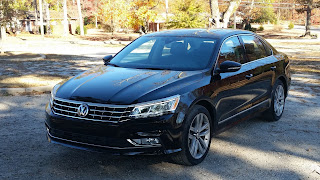Highlight: The vehicle we reviewed made audible announcements alerting the driver when approaching highway lanes narrowed or shifted.
Test Vehicle’s MSRP: $35,325 (base model $23,260)
Seating Capacity: 5
Standard Safety Features: airbags; ABS; automatic headlights; a rearview camera; a tire pressure monitoring system; and power adjustable side mirrors with integrated turn signals
Standard Equipment (S Model): 16-inch wheels; a 6-speed transmission; cloth seats; manual operated front seats; a manually adjustable tilt/telescopic steering wheel; a dual zone automatic climate control system; a 5-inch infotainment screen; power operated front seats with a memory control for the driver; heated front and rear seats; a leather wrapped steering wheel; and leather seats
1.8T SEL Premium: 18-inch wheels; 6-speed clutchless automatic
transmission; Daytime running lights; chrome exhaust tips; foldable power side mirrors; fog lights; power sunroof; a radar activated cruise control system; an automatic dimming rearview mirror; automatic rain-sensing wipers; a 6-inch touchscreen infotainment system; a navigation system; an automatic emergency braking system; heated exterior mirrors; a lane departure warning system; a parking distance control assist system; a remote engine start system; a push button keyless ignition system; an adjustable front center armrest
Options: Monster Mats
Other Trim Level: S; R-Line; SE; and SEL
Standard Audio On Test Vehicle: a 6-speaker audio system AM/FM/CD
Bluetooth Connectivity: Yes
USB Connectivity: Yes
Bumper-to-Bumper Warranty: 3 years or 36,000 miles
Powertrain Warranty: 5 years or 60,000 miles
Standard Engine/Horsepower: 1.8-liter, 4-cylinder/170-hp
Recommended Fuel: Regular
Standard Fuel Mileage: 25-city/36-hwy
What’s New: The brand’s large sedan has evolved for the 2016 model year, offering updated sheetmetal, although unnoticeable to the untrained eye, and a few interior upgrades to bring it in line with many of its competitors.
Why:
Since going through a major redesign a few years ago, the Passat is somewhat of
a segment buster. While the vehicle is classified as a midsize vehicle, its
interior and exterior dimensions lands as a tweener candidate for the large car
segment. The vehicle is roomy and quite
comfortable for long hauls. And for the most part, the layout of the features
on the instrument panel and the infotainment system are relatively easy to
operate.
Foremost,
the Passat joins the likes of Camry, Altima, Accord and Legacy, holding onto
its 6-cylinder engine, while offering a 4-cylinder, too. While the Passat we
reviewed was outfitted with the brand’s 4-cylinder turbo, we found the spirited
and peppy engine to be more than adequate. In fact, this is the only vehicle,
with a 4-cylinder in this segment, that did not seem underpowered. Also, being
that VW has close ties with Audi and Porsche, we could feel the precision drive
that makes both of its German luxury siblings segment standouts. In fact, the VW
offers the most engaging driving experience of any of its segment competitors.
And
as an added surprise, the standard 4-cylinder engine is capable of achieving
over 536 miles on a tank of gas, according to fueleconomy.gov. Needless to say,
the driving range is on par with a number of premium priced hybrids in the
segment.
Moreover,
the midsize vehicle borrows from its luxury siblings, offering a simple, but
thoughtfully organized instrument panel and infotainment center. In fact, the
vehicle now includes a standard rear view camera.
Added
to that, the vehicle offers a variety of trims, depending upon one’s budget or
taste. While the current vehicle still
has German heritage despite its appeal to American buyers, the vehicle still
managed to retain the German’s signature rear door lock system, which allows
the occupants to unlock and lock their own doors at the touch of a button.
But:
Because of its diesel entanglement, the fuel-efficient model that one was known
for achieving upwards of 750 miles on a tank of gas is no longer available.
And,
although the vehicle we reviewed was the higher-end premium model, we found
that the sliding front center armrest needed more padding.
Moreover,
it took us literally 10-minute to engage the complicated cruise control system.
We finally figured it out, after stumbling across an unmarked switch, which
finally activated the radar system. In our opinion, it should not require one
to access the owner’s manual in order to figure what should be an easy-to-use
function.
Furthermore,
many critics believe this current generation Passat has loss some of its luster
that separated the once heavily influenced German-engineered vehicle. The
American built and designed Passat has loss some of the agility and features
such as an electronic hold brake feature that once made the vehicle an
engineering standout the segment.
Lastly,
while the vehicle is larger and more fuel-efficient than many in the segment,
it is also priced a few more thousand more than a comparable 4-cylinder Camry
and Accord, which are the segment leaders. VW needs to relook at their premium
pricing strategy.
Verdict:
The Passat is
playing in a hyper-competitive segment. Although sales are down, just as the
majority of the vehicles that play into the midsize segment, the Passat remains
the brands number two best-selling vehicle. Although the vehicle received
some much needed interior updates to keep the vehicle competitive, the low
volume vehicle seems to compete against such niche players as the Mazda6, the
200 and the Legacy in terms of sales.
So,
while the Passat is larger than the vehicles in its competitive set, the folks in charge of content and pricing needs to consider a
price adjustment to bring the Passat more in line with the segment. Despite its
larger interior space, we are not quite sure why VW premium-priced this
vehicle. By taking our suggestion, VW
could possibly expand its reach beyond its current core audience.









No comments:
Post a Comment